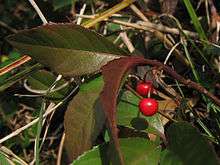Ardisia japonica
Ardisia japonica, known as marlberry,[1] is a species of Ardisia native to eastern Asia, in eastern China, Japan and Korea.[2]
| Ardisia japonica | |
|---|---|
 | |
| Scientific classification | |
| Kingdom: | Plantae |
| Clade: | Tracheophytes |
| Clade: | Angiosperms |
| Clade: | Eudicots |
| Clade: | Asterids |
| Order: | Ericales |
| Family: | Primulaceae |
| Genus: | Ardisia |
| Species: | A. japonica |
| Binomial name | |
| Ardisia japonica (Thunb.)Blume | |
Growth
It is a low-growing, spreading very quickly evergreen shrub 20–40 cm tall. The leaves are opposite or in whorls, ovate, 4–7 cm long and 1.5–4 cm broad, with a sharply serrated margin and an acute apex. The flowers are 4–10 mm diameter, with five (rarely six) white to pale pink petals; they are produced in racemes in late spring. The fruit is a drupe 5–6 mm diameter, red maturing dark purple-black in early winter.[2][3]
Uses
A number of cultivars have been selected for growing as ornamental plants, including 'Hakuokan' and 'Ito Fukurin' with variegated leaves, 'Hinotsukasa', with pale cream-coloured leaves, and 'Matsu Shima' with pink stems and variegated leaves.[3]
Medicinal uses
It is used as a medicinal plant in traditional Chinese medicine, where it is called zǐjīn niú (Chinese: 紫金牛),[2] or aidicha (矮地茶) and is considered one of the 50 Fundamental Herbs.[4]
Large doses of the plant as medicine can be toxic to the kidneys.[5]
Weed problems
It has escaped from cultivation and established itself in the wild in the United States, in Gainesville, Florida.[6]
See also
- Chinese herbology
- Ardisia crenata, (waxy leaves and red berries) also known as coral bush, coralberry tree, or spiceberry.
References
- English Names for Korean Native Plants (PDF). Pocheon: Korea National Arboretum. 2015. p. 358. ISBN 978-89-97450-98-5. Archived from the original (PDF) on 25 May 2017. Retrieved 4 January 2017 – via Korea Forest Service.
- Flora of China: Ardisia japonica
- Huxley, A., ed. (1992). New RHS Dictionary of Gardening. Macmillan ISBN 0-333-47494-5.
- Plants for a Future: Ardisia japonica
- Alternativehealing.org:Ardisia japonica
- 'Wildland Weeds" Summer 2009 p.4 accessed 6 June 2010
External links
| Wikimedia Commons has media related to Ardisia japonica. |